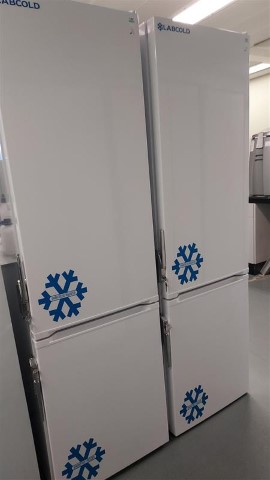We are pleased to publish details of a further two Salix grant-funded projects which we have now completed the energy saving measurements for. Over several weeks during spring 2021, a large number of lab refrigeration units at Whiteknights campus were replaced. These included refrigeration units, non-ultra-low temperature freezers (-20°C) and ultra-low temperature (ULT) freezers (-80°C).
Each project has produced good energy savings, with a combined total annual saving of £ 5,450 per year and 8.3 tonnes CO2 per year.
Why were the refrigeration units upgraded?
Most of the refrigeration units were aging and inefficient, using excess electricity and resulting in them emitting extra heat, which created overheating in the lab spaces.
Several of the units were 25-year-old or more, which were utilising high global-warming-potential refrigerants. Whilst these refrigerants are in sealed units, their removal is an important step in reducing the University’s environmental impacts.
The savings so far
With the Salix Finance-funded grant, 35 non-ultra-low refrigeration units were replaced with 32 new units, which ranged in size from tall, upright units to small countertop ones. We also replaced 12 ULT units with 12 new equivalents.

Like our drying oven project, meters were installed onto the refrigeration units prior to the retrofit, for us to accurately measure their energy consumption. The meter readings acted as our baseline, to record and compare with the energy consumption of the new units.
Once the refrigeration units were replaced, meters were installed onto the new units for a short period, to accurately record their energy consumption. For the non-ULT units, we have seen the individual energy savings produced by the units range from 14% – 73% depending on the model (and its use). For the ULT units, the individual energy savings produced range from 21% – 59%.
Overall, we have measured total cumulative savings from the non-ULT units annually as 9,084 kWh, which is the equivalent of removing 3 houses from the national grid*. When compared with the baseline figures, this is an overall saving of 35%. In financial terms, this equates to annual savings of £1,380, including due to the interactive effects resulting from the upgrades on space heating and cooling.
For the ULT units, the total annual cumulative saving is 26,770 kWh year, which is the equivalent of removing 9 houses from the national grid* and an overall saving of 41% compared to the baseline figures. The total monetary savings of this project are £4,069 per annum and the total carbon savings are 6.2 tonnes CO2 per year; equivalent to removing two average-use petrol cars from the road*.
As well as providing energy and monetary savings, the retrofit also provided benefits for lab users including a more comfortable working environment (due to the units no longer overheating lab-spaces), increased storage space even with an overall reduction of 3 units and better operational control of appliances.
The full energy savings reports are available for the ULTs here and the non-ULTs here. To learn more about the other Salix projects underway, you can read our Salix grant-funded articles here.
*Typical Domestic Consumption Values (TDCVs) are industry standard values for the annual gas and electricity usage of a typical domestic consumer and the 2020 figure released by Ofgem is 2,900 kWh
*BEIS medium petrol car figure is 0.30029 kgCO2e per mile, Department for Transport (2019) state the average miles a car is driven annually is 7,400 miles.

